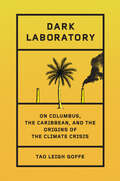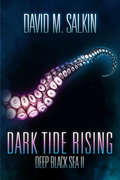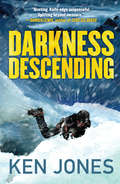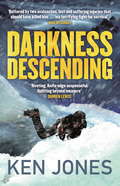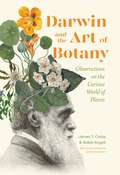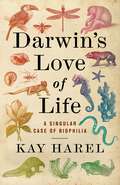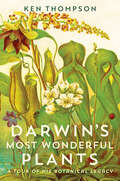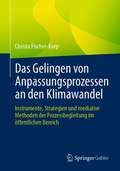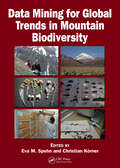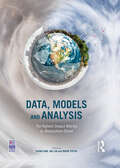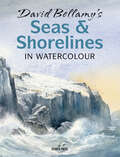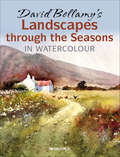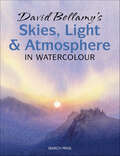- Table View
- List View
Dark Hunters (Bionicle)
by Greg FarshteyThe Dark Hunters stand in direct opposition to the Toa. But who are they? Where did they come from? And who - - or what -- motivates them? It's an inside look at the villains of the Bionicle world.
Dark Laboratory: On Columbus, the Caribbean, and the Origins of the Climate Crisis
by Tao Leigh GoffeA groundbreaking investigation of the Caribbean as both an idyll in the American imagination and a dark laboratory of Western experimentation, revealing secrets to racial and environmental progress that impact how we live today.&“Dark Laboratory is a gargantuan, soulful work. It obliterates most of what I thought I knew about the Caribbean&’s utility to Western Wealth.&” —Kiese Laymon, New York Times bestselling author of HeavyIn 1492, Christopher Columbus arrived on the Caribbean Island of Guanahaní to find an Edenic scene that was soon mythologized. But behind the myth of paradise, the Caribbean and its people would come to pay the price of relentless Western exploitation and abuse. In Dark Laboratory, Dr. Tao Leigh Goffe embarks on a historical journey to chart the forces that have shaped these islands: the legacy of slavery, indentured labor, and the forced toil of Chinese and enslaved Black people who mined the islands&’ bounty—including guano, which, at the time, was more valuable than gold—for the benefit of European powers and at the expense of the islands&’ sacred ecologies.Braiding together family history, cultural reportage, and social studies, Goffe radically transforms how we conceive of Blackness, the natural world, colonialism, and the climate crisis; and, in doing so, she deftly dismantles the many layers of entrenched imperialist thinking that shroud our established understanding of the human and environmental conditions to reveal the cause and effect of a global catastrophe. Dark Laboratory forces a reckoning with the received forms of knowledge that have led us astray.Through the lens of the Caribbean, both guide and warning of the man-made disasters that continue to plague our world, Goffe closely situates the origins of racism and climate catastrophe within a colonial context. And in redressing these twin apocalypses, Dark Laboratory becomes a record of the violence that continues to shape the Caribbean today. But it is also a declaration of hope, offering solutions toward a better future based on knowledge gleaned from island ecosystems, and an impassioned, urgent testament to the human capacity for change and renewal.
Dark Scenes from Damaged Earth: The Gothic Anthropocene
by Justin D. Edwards Rune Graulund Johan HöglundAn urgent volume of essays engages the Gothic to advance important perspectives on our geological era What can the Gothic teach us about our current geological era? More than just spooky, moonlit castles and morbid graveyards, the Gothic represents a vibrant, emergent perspective on the Anthropocene. In this volume, more than a dozen scholars move beyond longstanding perspectives on the Anthropocene—such as science fiction and apocalyptic narratives—to show that the Gothic offers a unique (and dark) interpretation of events like climate change, diminished ecosystems, and mass extinction.Embracing pop cultural phenomena like True Detective, Jaws, and Twin Peaks, as well as topics from the New Weird and prehistoric shark fiction to ruin porn and the &“monstroscene,&” Dark Scenes from Damaged Earth demonstrates the continuing vitality of the Gothic while opening important new paths of inquiry. These essays map a genealogy of the Gothic while providing fresh perspectives on the ongoing climate chaos, the North/South divide, issues of racialization, dark ecology, questions surrounding environmental justice, and much more.Contributors: Fred Botting, Kingston U; Timothy Clark, U of Durham; Rebecca Duncan, Linnaeus U; Michael Fuchs, U of Oldenburg, Germany; Esthie Hugo, U of Warwick; Dawn Keetley, Lehigh U; Laura R. Kremmel, South Dakota School of Mines and Technology; Timothy Morton, Rice U; Barry Murnane, U of Oxford; Jennifer Schell, U of Alaska Fairbanks; Lisa M. Vetere, Monmouth U; Sara Wasson, Lancaster U; Jeffrey Andrew Weinstock, Central Michigan U.
Dark Tide Rising (Deep Black Sea #2)
by David M. SalkinUnderwater horror rises to the surface in this science fiction thriller from the author “who knows the details of deep-sea exploration firsthand” (Ben Bova, Hugo Award-wining author).A Japanese fishing trawler becomes a ghost ship.A pleasure yacht is under attack by unknown sea creatures.A Coast Guard crew is massacred by something not of this world.Ted Bell had only one personal goal—to reach Mars. He believed that harnessing the power of the deep-sea bacteria that allows creatures to live in super-heated, poisonous water might get humans to deep space. But when Ted intentionally infected a member of the crew for his own agenda, it didn’t go as planned. A new life form was created–completely out of control. Ted’s failed experiment doomed the crew of the USS Challenger.After living through the terrifying disaster that killed half the crew, three survivors think they have escaped the nightmare. Instead, the creatures have risen from the depths—and the three discover that the horrifying experience on the Challenger was only the beginning.Praise for Deep Black Sea“Spine-tingling terror . . . An exciting read!” —Ben Bova, Hugo Award-winning author“Crichton at his best is the main author who comes to mind as a comparable influence when reading Deep Black Sea . . . The informative and fascinating science that fills each page really elevates this book to a higher grade.” —Horror Novel Reviews
Dark Wild Realm
by Michael CollierThe award-winning poet Michael Collier’s elegiac fifth collection is haunted by spectral figures and a strange, vivid chorus of birds: From a cardinal that crashes into a window to a gathering of turkey vultures, Collier engages birds as myth-makers and lively messengers, carrying memories from lost friends. The mystery of death and the vital absence it creates are the real subjects of the book. Collier juxtaposes moments of quotidian revelation, like waking to the laughing sounds of bird song, with the drama of Greek tragedy, taking on voices from Medea. As Vanity Fair praised, his poems “tread nimbly between moments of everyday transcendence and spiritual pining.”
Dark. Sweet.
by Linda HoganDark. Sweet. offers readers the sweep of Linda Hogan's work--environmental and spiritual concerns, her Chickasaw heritage--in spare, elemental, visionary language.From "Those Who Thunder":Those who thunderhave dark hairand red throw rugs.They burn paper in bathroom sinks.Their voices refuse to sufferand their silences know the waystraight to the heart;it's bus route number eight.Linda Hogan is the recipient of the 2007 Mountains and Plains Booksellers Spirit of the West Literary Achievement Award. Her poetry has received an American Book Award, Colorado Book Award, and a National Book Critics Circle nomination.
Darkest Hour (Heartland #13)
by Lauren BrookeWhen Heartland is quarantined due to an equine flu, Amy learns there are limits to what she can do.
Darkness Descending
by Ken JonesIn January 2003, Ken Jones, an adventurer and former British Special Forces soldier, was caught in a devastating avalanche as he climbed deep in the frozen wilderness of Romania's Carpathian Mountains. Swept over the edge of a 75-foot cliff, he plummeted to the rocks below. Against all odds, he survived the fall--regaining consciousness shrouded in darkness and sub-zero temperatures, separated from his supplies, and in excruciating pain from a broken leg and shattered pelvis. With frostbite and internal bleeding beginning to take their toll, Jones summoned his deepest will to live and began three agonizing days dragging himself over frozen terrain to safety--only to discover that his true ordeal was yet to begin. The doctors who initially treated him were astonished that any person could sustain such massive trauma and exposure and still be alive. Then, after an initial round of extensive surgeries and recoveries that equaled if not exceeded the pain of the injuries themselves, Jones was told he would almost certainly never walk again. Over the next two years he endured constant physical therapy and additional surgery, with latent effects from the fall still threatening his life. At one point, he slipped into unconsciousness under anesthesia just as he heard a doctor telling his mother he was going to die. But with a soldier's heart he made his way to recovery, regained full mobility, and has made his story known in this remarkable book. In the bestselling tradition of Into Thin Air and Touching the Void, Darkness Descending is a classic tale of triumph over adversity and what it means to never give up. Jones's remarkable feat has already been featured on Animal Planet's hit series I Shouldn't Be Alive, and stands tall as an unforgettable testament to the strength of the human spirit.
Darkness Descending
by Ken JonesAn astonishing true story of mountaineering survivalOn 5 January 2003, former Special Forces soldier Ken Jones was caught in a devastating avalanche as he climbed in the frozen wilderness of Romania's Transylvanian Alps. Flung from a cliff, he regained consciousness to find himself shrouded in darkness, separated from his supplies, suffering from overexposure in the sub zero-temperatures and in horrendous pain from a broken leg and shattered pelvis. Heavily frostbitten and bleeding internally, Ken dragged himself to safety over three agonizing days only to discover that his true ordeal had yet to begin. His account of life saving surgery and his battle to walk again is a classic tale of triumph over adversity and what it means to never give up. Heart stopping and inspiring to the very last page, Ken Jones's story of endurance and survival is an unforgettable testament to the strength of the human spirit.
Darkness Descending
by Ken JonesAn astonishing true story of mountaineering survivalOn 5 January 2003, former Special Forces soldier Ken Jones was caught in a devastating avalanche as he climbed in the frozen wilderness of Romania's Transylvanian Alps. Flung from a cliff, he regained consciousness to find himself shrouded in darkness, separated from his supplies, suffering from overexposure in the sub zero-temperatures and in horrendous pain from a broken leg and shattered pelvis. Heavily frostbitten and bleeding internally, Ken dragged himself to safety over three agonizing days only to discover that his true ordeal had yet to begin. His account of life saving surgery and his battle to walk again is a classic tale of triumph over adversity and what it means to never give up. Heart stopping and inspiring to the very last page, Ken Jones's story of endurance and survival is an unforgettable testament to the strength of the human spirit.
Darkness Visible: A Study of Vergil's "Aeneid"
by W.R. JohnsonOne of the best books ever written on one of humanity’s greatest epics, W. R. Johnson’s classic study of Vergil’s Aeneid challenges centuries of received wisdom. Johnson rejects the political and historical reading of the epic as a record of the glorious prehistory of Rome and instead foregrounds Vergil’s enigmatic style and questioning of the heroic myths. With an approach to the text that is both grounded in scholarship and intensely personal, and in a style both rhetorically elegant and passionate, Johnson offers readings of specific passages that are nuanced and suggestive as he focuses on the “somber and nourishing fictions” in Vergil’s poem. A timeless work of scholarship, Darkness Visible will enthrall classicists as well as students and scholars of the history of criticism—specifically the way in which politics influence modern readings of the classics—and of poetry and literature.
Darwin and the Art of Botany: Observations on the Curious World of Plants
by James T. Costa Bobbi AngellUncover Darwin&’s most important writings about plants with this important collection featuring expert interpretations and rare illustrations. Charles Darwin is best known for his work on the evolution of animals, but in fact a large part of his contribution to the natural sciences is focused on plants. His observations are crucial to our modern understanding of everything from the amazing pollination process of orchids to the way that vines climb. Darwin and the Art of Botany collects writings from six often overlooked texts devoted entirely to plants, and pairs each excerpt with beautiful botanical art from the library at the Oak Spring Garden Foundation, creating a gorgeously illustrated volume that never existed in Darwin's own lifetime, and hasn't since. Evolutionary botanist and science historian James Costa brings his expertise to each entry, situating Darwin's words in the context of the knowledge and research of the time. The result is a new way of visualizing Darwin's work, and a greater understanding of the ways he's shaped our world.
Darwin's Love of Life: A Singular Case of Biophilia
by Karen L. HarelBiophilia—the love of life—encompasses the drive to survive, a sense of kinship with all life-forms, and an instinct for beauty. In this unconventional book, Kay Harel uses biophilia as a lens to explore Charles Darwin’s life and thought in deeply original ways. In a set of interrelated essays, she considers how the love of life enabled him to see otherwise unseen evolutionary truths.Harel traces the influence of biophilia on Darwin’s views of dogs, facts, thought, emotion, and beauty, informed by little-known material from his private notebooks. She argues that much of what Darwin described, envisioned, and felt was biophilia in action. Closing the book is a profile of Darwin’s marriage to Emma Wedgwood, his first cousin, a woman gifted in music and medicine who shared her husband’s love of life.Harel’s meditative, playful, and lyrical musings draw on the tools of varied disciplines—aesthetics, astronomy, biology, evolutionary theory, history of science, philosophy, psychiatry, and more—while remaining unbounded by any particular one. Taking unexpected paths to recast a figure we thought we knew, this book offers readers a different Darwin: a man full of love, joy, awe, humility, curiosity, and a zest for living.
Darwin's Man in Brazil: The Evolving Science of Fritz Müller
by David A. WestFritz Müller (1821-1897), though not as well known as his colleague Charles Darwin, belongs in the cohort of great nineteenth-century naturalists. Recovering Müller's legacy, David A. West describes the close intellectual kinship between Müller and Darwin and details a lively correspondence that spanned seventeen years. The two scientists, despite living on separate continents, often discussed new research topics and exchanged groundbreaking ideas that unequivocally moved the field of evolutionary biology forward. Müller was unique among naturalists testing Darwin's theory of natural selection because he investigated an enormous diversity of plants and animals, corresponded with prominent scientists, and published important articles in Germany, England, the United States, and Brazil. Darwin frequently praised Müller's powers of observation and interpretation, counting him among those scientists whose opinions he valued most. Despite the importance and scope of his work, however, Müller is known for relatively few of his discoveries. West remedies this oversight, chronicling the life and work of this remarkable and overlooked man of science.
Darwin's Most Wonderful Plants: A Tour of His Botanical Legacy
by Ken ThompsonFor many people, the story of Charles Darwin goes like this: he ventured to the Galapagos Islands on the Beagle, was inspired by the biodiversity of the birds he saw there, and immediately returned home to write his theory of evolution. But this simplified narrative is inaccurate and lacking: it leaves out a major part of Darwin’s legacy. He published On the Origin of Species nearly thirty years after his voyages. And much of his life was spent experimenting with and observing plants. Darwin was a brilliant and revolutionary botanist whose observations and theories were far ahead of his time. With Darwin’s Most Wonderful Plants, biologist and gardening expert Ken Thompson restores this important aspect of Darwin’s biography while also delighting in the botanical world that captivated the famous scientist. Thompson traces how well Darwin’s discoveries have held up, revealing that many are remarkably long-lasting. Some findings are only now being confirmed and extended by high-tech modern research, while some have been corrected through recent analysis. We learn from Thompson how Darwin used plants to shape his most famous theory and then later how he used that theory to further push the boundaries of botanical knowledge. We also get to look over Darwin’s shoulder as he labors, learning more about his approach to research and his astonishing capacity for hard work. Darwin’s genius was to see the wonder and the significance in the ordinary and mundane, in the things that most people wouldn’t look at twice. Both Thompson and Darwin share a love for our most wonderful plants and the remarkable secrets they can unlock. This book will instill that same joy in casual gardeners and botany aficionados alike.
Das EEG im Wandel 2010 - 2017 (Energietransformation)
by Jörn SchaubeJörn Schaube untersucht mit dem EEG eine zentrale Policy der deutschen Energiewende. Sein Interesse gilt dabei den Novellierungen der Jahre 2011/2012, 2014 und 2016 und dem im Rahmen dieser Novellen zu verzeichnenden Policy-Wandel. Der Autor analysiert, wie weitreichend der seit 2010 stattfindende dynamische Wandel der Politikziele und -instrumente im EEG war und mit welchen Variablen er erklärt werden kann. Dabei legt er besonderes Augenmerk auf die Akteursstruktur im Policy Subsystem EEG. Das theoretische Fundament der Untersuchung bilden mit dem Advocacy Coalition Framework und der Machtressourcentheorie folglich zwei Konzepte, die bzgl. der Erklärung von Policy-Wandel auf der Ebene der Akteure ansetzen, dabei jedoch unterschiedliche, sich ergänzende Perspektiven einnehmen. Auf Ebene der abhängigen Variable (Veränderungen des EEG) identifiziert der Autor eine spannende Varianz im Hinblick auf die Veränderungsdynamik im Zähler und im Nenner des EEG. Während er die Veränderungen im Zähler des Gesetzes als umfassenden Politikwandel qualifiziert, kann er „im Nenner“ weitgehende Stabilität diagnostizieren, obwohl die seit 2012 dominierende Kostendebatte auch hier Änderungen hätten erwarten lassen.
Das Gelingen von Anpassungsprozessen an den Klimawandel: Instrumente, Strategien und mediative Methoden der Prozessbegleitung im öffentlichen Bereich
by Christa Fischer-KorpDieses Buch gibt Hilfestellungen für Gemeinden, um die mit dem Klimawandel verbundenen Herausforderungen zu meistern und dabei alle Interessensgruppen zu beteiligen. Fast alle Gemeinden stehen vor der Frage, wie die Anpassung an den Klimawandel für die Bürger vonstattengehen soll. Jede Gruppe, jede Institution, jeder Betrieb wird Bedürfnisse artikulieren und die eigenen Interessen verteidigen. Das Buch zeigt auf, wie in den Kommunen Konfliktfähigkeit hergestellt werden kann, wie die Herausforderungen für Gemeinden und Regionen analysiert und maßgeschneiderte Strategien für den Anpassungsprozess entwickelt werden können. Der Anpassungsprozess an den Klimawandel muss so gestaltet werden, dass Bedürfnisse beachtet werden und Interessen nach Möglichkeit ausgeglichen sind. Es braucht Kooperationen, Innovationen und den Blick für Synergien, um diese Aufgabe zu bewältigen. Ein besonderer Schwerpunkt liegt hier auf der Begleitung und Unterstützung durch Mediatoren. Die Autorin gibt den Verantwortlichen zahlreiche Praxisbeispiele, Analyse-Tools und Checklisten an die Hand. Damit wendet sich das Buch vor allem an Bürgermeister, Gemeindeverantwortliche, Klimabeauftragte, Anbieter von „grünen“ Projekten und an alle, die wollen, dass die Anpassung an den Klimawandel gelingt.
Data Mining for Global Trends in Mountain Biodiversity
by Christian Körner Eva M. SpehnThanks to advances in electronic archiving of biodiversity data and the digitization of climate and other geophysical data, a new era in biogeography, functional ecology, and evolutionary ecology has begun. In Data Mining for Global Trends in Mountain Biodiversity, Christian Korner, Eva M. Spehn, and a team of experts from the Global Mountain Biodi
Data, Models and Analysis: The Highest Impact Articles in 'Atmosphere-Ocean'
by Guoqi Han, Hai Lin and Douw SteynThis volume contains the ten most cited articles that have appeared in the journal Atmosphere-Ocean since 1995. These articles cover a wide range of topics in meteorology, climatology and oceanography. Modelling work is represented in five papers, covering global climate model development; a cumulus parameterization scheme for global climate models; development of a regional forecast modelling system and parameterization of peatland hydraulic processes for climate models. Data rehabilitation and compilation in order to support trend analysis work on comprehensive precipitation and temperature data sets is presented in four papers. Field studies are represented by a paper on the circumpolar lead system. While the modelling studies are global in their application and applicability, the data analysis and field study papers cover environments that are specifically, but not uniquely, Canadian. This book will be of interest to researchers, students and professionals in the various sub-fields of meteorology, oceanography and climate science.
Dave and His Dog, Mulligan
by Jim KjelgaardDave Keller had a good job at Marcy's Filling Station, but his dream was to become a game warden--and be as fine and devoted a warden as his father was. However, the waiting list for warden jobs was very long and the qualifications to be met were exacting. Dave had a second big dream for the future. He wanted to prove that hunting the “varmints”--the coyotes, bobcats, and lions that ran rampant in the nearby countryside--could prove a challenging, diverting sport to the countless hunters who swarmed into the area each open season, mostly in quest of deer. He hoped this type of hunting would put a stop to the reckless placing of poisoned bait by ruthless sheepmen whose flocks were being raided by the varmints. Dave's invaluable sidekick and aid in his every campaign was his loyal companion, Mulligan--a giant of a dog, who, like the famed stew, had a mingled makeup, but who feared no bobcat! How Dave moved toward his first goal through the second--with the help of Mulligan and an idealistic sportsman whose life they saved--offers worthwhile reading. By the author of Two Dogs and a Horse, etc.
David Attenborough Lines to Live By: Embrace the wonder of your world
by Pop Press'I am hopeful for the future, because although nature is in crisis, now is the time for action.'For 70 years, David Attenborough's soothing voice has brought the magic of nature to our TV screens, teaching millions around the world about beautiful animals and the climate crisis that endangers them.David Attenborough Lines to Live By is a celebration of Sir David's impact on the natural world and will inspire everyone to appreciate and protect the fragile world around us.
David Bellamy's Seas & Shorelines in Watercolour
by David BellamyLearn to paint the varied and dramatic coastlines of the world, with this guide from the expert teacher—includes four step-by-step demonstrations.Renowned watercolourist David Bellamy shares his passion for painting seas and shorelines in this inspiring and practical book. His extensive travels mean that seas and shorelines from all over the world appear in the paintings—and you can benefit from his knowledge and experience with advice on:finding subjects and painting the different moods of the searocks, crags and cliffsadding figures and animals into your artworksAlso included is an in-depth look at the painting and sketching techniques required, so painters at every level can start creating their own beautiful seascapes.
David Bellamy’s Landscapes through the Seasons in Watercolour
by David BellamyMaster artist and best-selling author David Bellamy shares with you his techniques, ideas and approach to painting his beloved landscape throughout the year. A revised and expanded edition of David Bellamy's Winter Landscapes in Watercolour, David looks at each season in detail and explores the challenges and surprises they present to the landscape artist.Also covered are learning techniques for seasonal effects such as rendering hoar frost on trees; misty and atmospheric effects; injecting rogue colours to add excitement to your work; how to tackle a variety of tree branches for different species; depicting light branches against dark backgrounds; altering the composition to suit your needs, and so much more.
David Bellamy’s Skies, Light and Atmosphere in Watercolour
by David BellamyIn this second book in a series covering elements of the landscape, renowned watercolourist, David Bellamy shows how to paint skies, light and atmosphere and how choices involving these three key elements can affect a painting. Starting with skies, David Bellamy covers basic techniques, composition, clouds, special effects like silver linings, sunsets and shafts of light, and much more, then there is a step by step dramatic sky demonstration. Next comes light, with plenty of advice including warm and cool light, using glazes, cast shadows, light from different directions, painting the sun and reflected light, followed by a step by step demonstration featuring strong light and shadow. The atmosphere section covers haze and mist, fog, mountains in cloud, smoke and steam, rain, storms and tranquil moods, and is followed by an atmospheric step by step painting of a waterfall. David Bellamy’s extensive travels and much admired painting style ensure that there are plenty of beautiful, inspiring paintings of skies, light and atmosphere throughout the book.
David Foster Wallace and the Body (Routledge Studies in Contemporary Literature)
by Peter SloaneDavid Foster Wallace and the Body is the first full-length study to focus on Wallace’s career-long fascination with the human body and the textual representation of the body. The book provides engaging, accessible close readings that highlight the importance of the overlooked, and yet central theme of all of this major American author’s works: having a body. Wallace repeatedly made clear that good fiction is about what it means to be a ‘human being’. A large part of what that means is having a body, and being conscious of the conflicts that arise, morally and physically, as a result; a fact with which, as Wallace forcefully and convincingly argues, we all desire ‘to be reconciled’. Given the ubiquity of the themes of embodiment in Wallace’s work, this study is an important addition to an expanding field. The book also opens up the themes addressed to interrogate aspects of contemporary literature, culture, and society more generally, placing Wallace’s works in the history of literary and philosophical engagements with the brute fact of embodiment.

